Working with scientific literature - Outlining, citing, plagiarism
Motivation
Working with scientific literature is a fundamental aspect of being a scientist. It is crucial to understand what others have already accomplished and published on a given topic, which necessitates reading the relevant literature.
When planning and designing projects and experiments, it is essential to be familiar with the state-of-the-art methods in order to develop the best possible work plan. During the writing of a Master’s thesis or scientific publications, it is necessary to summarize the current state of the field and contextualize one’s own results within existing knowledge. This requires effective strategies for finding and accessing key publications in a particular research area.
Because scientific writing is often complex, dense, and at times convoluted, it is helpful to apply techniques for extracting the essential concepts and ideas from a publication.
When we are referencing other literature we have to be careful not to just copy and paste it in addition to referencing referencing it because one often needs summarize ideas and results of other researchers and use them in one’s own writings. Giving proper credit to the authors of referenced, summarized literature an essential part of working with scientific literature. For this reason it is very important to know the basic rules of how to avoid plagiarism.
AI and the scientific literature
The way we work with and engage with scientific literature is changing rapidly due to the digital revolution. Since scientific literature is primarily text-based, it is highly suitable for analysis using deep learning techniques, leading to significant developments that impact how we produce new and interact with existing research publications
As researchers, it is crucial to understand what tasks can be reliably delegated to machines or large language models and where human input—our creativity, knowledge, and intelligence—remains essential in conducting scientific work and interacting with the literature.
Given the rapid pace of these developments, it is difficult to predict the future direction of this transformation. As a result, we must continually adapt, learning new tools and workflows to stay effective when working with scientific literature.
How to deal with complex scientific texts?
Much of scientific writing is characterized by complicated, sometimes obfuscated writing. For reading and understanding such texts, and to extract the main points, it is necessary to structure them.
Some of these strategies will be described in the following.
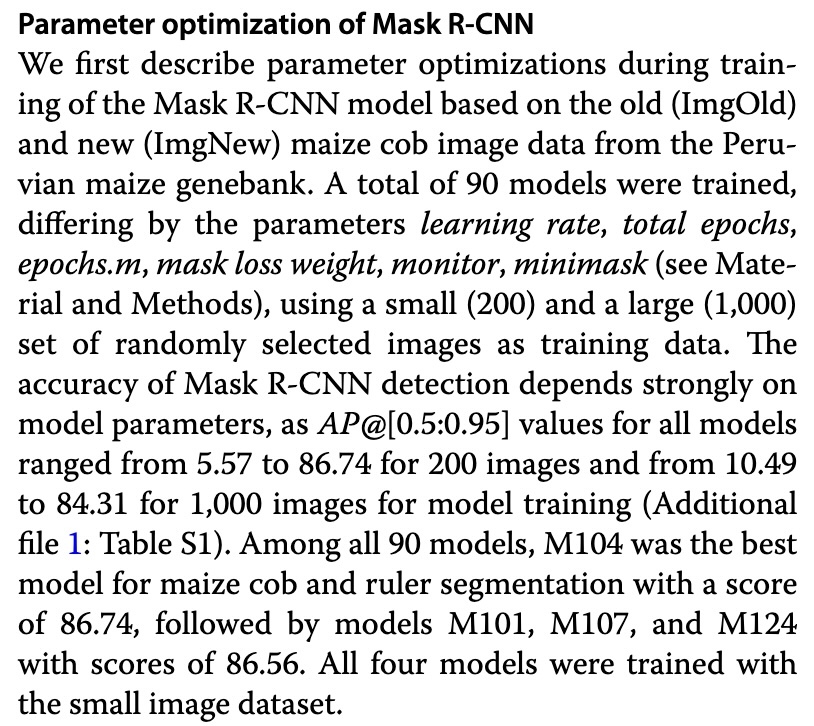
There are several contexts in which the summarizing of scientific information is highly useful. Summarizing information is therefore an essential skill in many aspects of scientific work.
It is particularly useful when studying complex texts or dense mathematical concepts, as it helps distill the key points and improve understanding.
Summarization is also crucial when writing an abstract for a publication or crafting a concise summary, such as for a scientific review, where the goal is to capture the essence of a larger body of work.
Another important reason to summarize is to avoid plagiarism by restating ideas in your own words, thus demonstrating comprehension rather than copying directly.
Summarizing can also help structure your thoughts when preparing to write, ensuring that your ideas flow logically and coherently.
Additionally, summarization aids in understanding and communicating ideas or knowledge, which can be especially powerful by visualizing concepts. A notable historical example of a visualization is Charles Darwin’s notebook Figure 2, where he visualized the concept of the phylogenetic tree, which was a breakthrough in understanding evolutionary relationships.
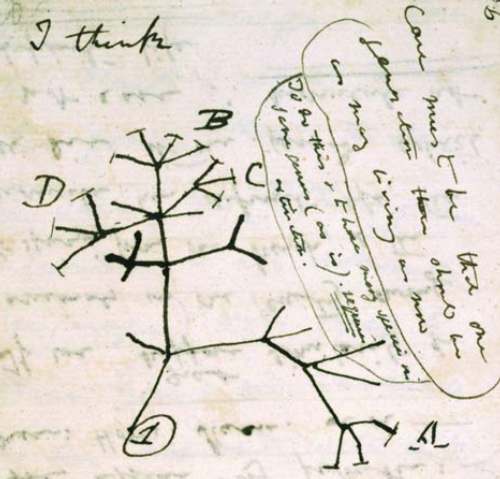
The primary goal of summarizing information, as both a student and a researcher, is to create active knowledge. This involves reading and understanding a text, then simplifying it to make it more accessible, not only for yourself but also for the readers of your scientific research and writing. By summarizing key concepts, you can help others more easily grasp the essential points of your work.
A crucial part of summarization involves abstraction, conceptualization, and simplification. This can be achieved through techniques such as outlining, which we will explore in the following sections.
Tools and techniques for outlining.
Outlining is a powerful tool for organizing and simplifying complex information. It allows you to assemble data at a high density while reducing complexity, making it easier to digest and process.
By extracting the key concepts and ideas from a larger text, outlining helps structuring intricate or poorly written material into manageable parts, providing clarity.
It is also an effective method for avoiding plagiarism, as it encourages rephrasing and conceptualizing information in your own words.
Outlining enables you to structure the line of arguments logically, ensuring coherence and flow in your work.
This is an active process that aids in memorizing and understanding the material more deeply. As you outline, you engage in a creative process by starting with simple elements and progressively building complexity, often discovering new connections between ideas.
This approach not only enhances comprehension but also fosters critical thinking and creativity in organizing your research and writing.
Tools for structuring and summarizing information
There are numerous tools and strategies available for effectively outlining and summarizing information, utilizing both textual and visual approaches.
One common method is creating outlines, which organize ideas in a structured, hierarchical format by writing summary sentences. Outlines can be used for summarizing existing literature or for designing new scientific writing1
Ideally, the writing of an outline of an existing text would be to read it and to think of a single sentence that describes each paragraph or section in it. More “mechanical” approaches for outlining involve either combining the first sentences of paragraphs, as these often provide a summary of the main idea, or alternatively, finding and copying key sentences from each paragraph to capture the core concepts.
For visual strategies, mind maps and concept maps (which can follow a clustering or branching structure) are useful for showing relationships between ideas.
Schemas or infographics—often referred to as “back-of-the-envelope drawings”—can provide a quick and clear overview of complex information.
Timelines are effective for organizing information chronologically, while note cards or the Zettelkasten method allow you to record and arrange bits of information flexibly, building a larger, coherent structure. These strategies enable you to visually and textually simplify, organize, and connect ideas, improving both comprehension and communication.
The following Note 1 shows a general scheme for an outline and then a specific implementation.
Using such an outline, any missing parts in the line of arguments and in the “story line” can be identified. The outline can be used to distribute the writing of a longer text into smaller tasks that are easier to manage. Each item on a task list can be defined as a writing goal, which my contribute to the motivation.
Tools for text-based outlining
There are a variety of tools available to assist with outlining, ranging from traditional methods to more advanced digital options.
The most straightforward and accessible tool is simply pen and paper, which allows for quick sketching and outlining anywhere.
For digital note-taking, apps like Microsoft OneNote offer flexible and organized ways to structure ideas.
Word processors such as Microsoft Word and Libre Office include built-in outlining functions that can help create hierarchical structures.
Many text editors include the possibility to write structured and hierarchical outlines. Examples are RStudio, VSCode as well es the classical text editors vi and Emacs. The org-mode subsystem (see the Org-mode website provides an extremely powerful text-based outlining system that can also be used with other editors such as vi or VSCode.
For more visual approaches, Freeplane (Website) is a useful tool that supports both outlining and mind mapping.
Outlining can be combined with knowledge management and the construction of a personal knowledge database.
Note cards are the classical, paper-based approach to condense information. In particular, the Zettelkasten (box of note cards) method, with its emphasis on organizing small, interconnected notes, can be used effectively through various tools that support this approach.
The German sociologist Niklas Lumann (1927-1998) maintained a huge Zettelkasten, which he used to store his information (in the pre-computer age) and to assemble his books from the individual notes. It has been digitized and can be accessed here.
Numerous programs are available for the digital version of a knowledgebase, of which TiddlyWiki (https://tiddlywiki.com) and Obsidian (https://obsidian.md/) are interesting free tools.
Notes can also be created in the Zotero reference manager.
Text-editors offer similar systems such as the denote or org-roam libraries in the powerful Emacs text editor.
More tools can be found on Wikipedia.
A key aspect of digital knowledge bases is the extensive use of tags and hyperlinks. Tags allow a non-hierarchical connection of notes, and since individual notes can have multiple tags, the knowledge can be summarized in many different contexts.
Tools for visual outlining
Mind mapping is a visual tool that helps organize and connect ideas. It allows you to visually represent relationships between concepts by creating branches that radiate from a central idea, making complex topics easier to understand. Mind maps are especially useful for brainstorming, planning, and structuring projects but also to structure academic texts. They enable you to break down larger concepts into smaller, more manageable parts, fostering creative thinking and exploration.
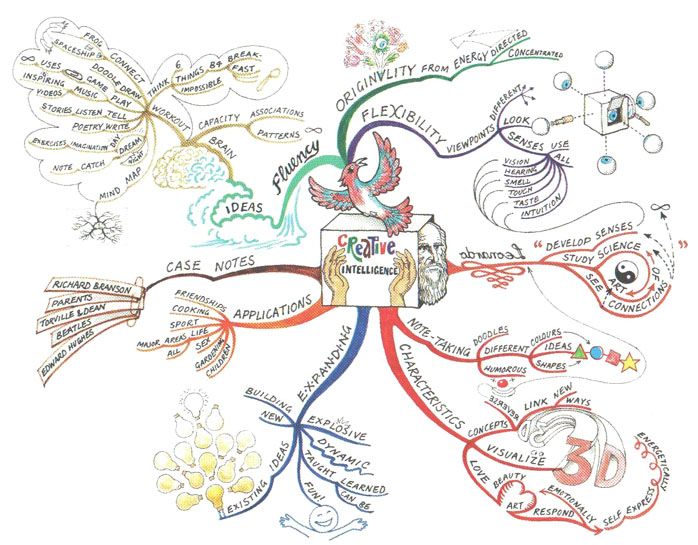
For more information and software tools for creating mind maps, refer to Wikipedia.
A concept map is another type of visual representation, specifically designed to illustrate the relationships between different concepts. Concept maps are often used in academic and scientific contexts to clarify complex topics, showing how various ideas or components are interrelated. This makes them valuable for summarizing research, structuring knowledge, and communicating structured information. Concept maps are often used in the introductory section of publications to illustrate concepts that play a role in the publication.
The challenge with concept maps is to find the optimal level of abstraction and detail in order not to overload the visualization and distract the core message.
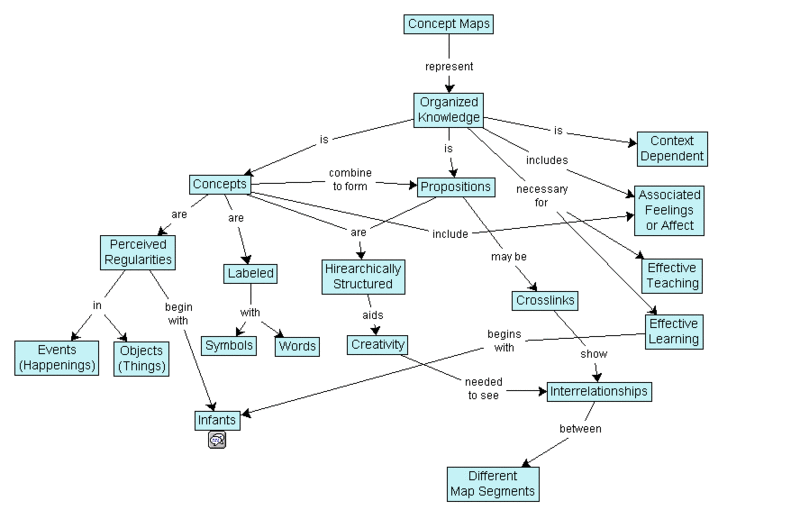
Schemas are simplified visualizations related to concept maps, presenting a streamlined version of an idea or system. They help clarify complex concepts by breaking them down into their most essential components. For example Figure 1 (Link) in Heffner et al. (2009) attempts to explain the method of genomic selection in breeding in a single scheme.
Infographics, on the other hand, are used to visually present data in an engaging and accessible way, often combining text, images, and charts to convey information clearly and quickly. Figure 1 (Link) in Bar-On et al. (2018) shows the global distribution of biomass by taxa as an infographic in a new, but quantitatively correct manner.
A quick, informal way to create conceptual visualizations is through napkin drawings or back-of-the-envelope drawings, which allow you to sketch out ideas rapidly. Both term reflect to accidential conversations among colleagues where napkins in a restaurant or letter envelops are used for drawing to visualize a concept. The website thisisindexed.com has many fun examples of such drawings (e.g., this one).
Timelines are a useful tool for presenting temporal information, showing events or developments in a clear, linear fashion. They are particularly helpful in academic contexts for visualizing the progression of research, technological advancements, or historical events.
Figure 5 shows a timeline, in which various developments for the use of molecular markers in genetics are shown. The individual events contain references to the respective scientific publications.
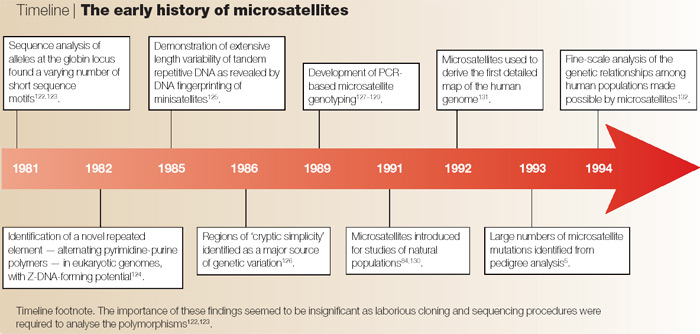
In summary, each of these visualization techniques serve different purposes. They help to simplify, clarify, and communicate complex information in academic and scientific work. They are also indicative that scientific research has a creative component in the communication of results because such “free style” graphics can be used to develop and plan new research ideas and projects, but also present ideas, concepts, summaries of one’s on research etc. for example in the introduction or discussion sections of publications (and master theses, for that matter).
Citing in academic writing
Why are references needed?
The citation of other publications is an essential component of academic writing.
References to the literature
- provide a framework for our research \(\rightarrow\) Introduction to a scientific paper.
- refer to previously published materials, methods and protocols \(\rightarrow\) Materials and Methods section
- compare our results to other literature \(\rightarrow\) Discussion section
One question is how references can be cited correctly.
Figure 6 shows the original publication:
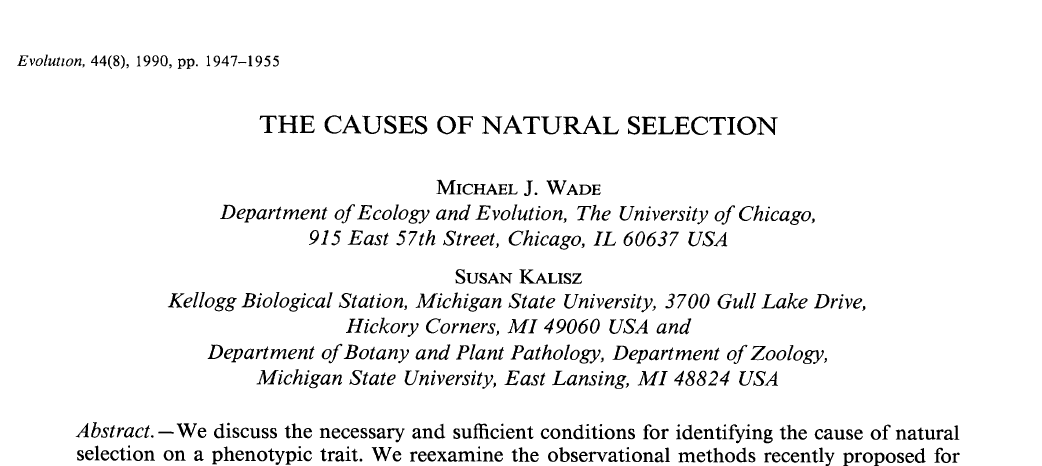
From this the name of the authors, year of publication, title of the publication, journal name, volumne and page numbers can be extracted. Taken together, these pieces of information provide a unique identifier to the publication as in the following, standard format of a reference:
Wade, M.J. & Kalisz, S. (1990) The causes of natural selection. Evolution, 44, 1947-1955.
In scientific writing, references are used in two locations:
- In the text
- In the bibliography
Citation styles in the bibliography
Different journals and book publishers use different citation styles. Therefore, the same scientific publication can be cited with different styles, depending on the requirements of the journal or the publisher.
Standard plain text:
Wade, M.J. & Kalisz, S. (1990) The causes of natural selection. Evolution, 44, 1947-1955.
APA citation style (American Psychological Association - http://www.apastyle.org):
Wade, M.J. & Kalisz, S. (1990) The causes of natural selection. Evolution, 44, 1947-1955.
Chicago Manual of Style (http:www.chicagomanualofstyle.org):
Wade, M.J., & S. Kalisz. 1990. The causes of natural selection. Evolution 44: 1947-1955.
Unfortunately, most scientific journals have their own citation style, and adjusting the format to each journal can take considerable time, if you don’t use a reference manager such as Zotero.
Importantly, using a reference manager also ensures that the references are formatted in the same style in the bibliography, which can be reasonably well achieved. Many reference manager and also publishing systems like Quarto make it easy to adapt the format to a certain journal style by using so-called citation style language (CSL) style files that describe the format of a journal.
This repository on Github (Link) has a large collection of CSL files and this page (Link) in the Quarto documentation shows how easy it is to define the specific citation style using a CSL file that was downloaded.
A consistent and correct formatting of the bibliography is frequently used as one evaluation criterion for master theses. For this reason, it is a good idea to use a reference manager such as Zotero instead of adding references manually to a thesis.
How to cite in the text
In the following we dicuss guidelines on how to cite literature in the text of a publication. We demonstrate this with the following examples.
Original text:
“The mean fitness of a manipulated study population can be different from the natural population.”
Direct referencing:
“According to Wade and Kalisz (1990), the mean fitness of a manipulated study population may differ from the mean fitness of a natural population.”
Indirect referencing:
“However, the mean fitness of a study population may differ from the mean fitness of the natural population (Wade and Kalisz, 1990).”
As a general rule, try to avoid verbatim quotations of text in scientific literature.
The following is a bad example:
“Evolutionary experiments can be used to investigate the effect of natural selection on the fitness of a population. However, ``The mean fitness of a manipulated study population can be different from the natural population’’ (Wade and Kalisz 1990).”
In contrast, a good example:
“Evolutionary experiments can be used to investigate the effect of natural selection on the fitness of a population, but the mean fitness of manipulated study populations may differ from natural populations (Wade and Kalisz 1990).”
Manage your references
In scientific works such as the master thesis, the number of references can become large, and the editing (and formatting) of references a lot of work. For this reason, reference manager are very useful for some of this work.
For writing scientific publications, there are two major ecosystems. They can be best differentiated into What You See Is What You Get (WYSIWYG) and What You Get is What You Want (WYGIWYW) systems. The latter are somewhat difficult to learn, but more powerful, especially when complex graphics and mathematical formulas are part of the publication.
Some reference managers work in both ecosystems, others are restricted to one ecosystems.
The non-commercial and open source reference manager Zotero (zotero.org) has emerged as a very popular reference manager because it works with different types of text editors including Microsoft Word, LibreOffice, GoogleDocs, LaTeX and the Quarto publishing system. Zotero is also supported by text editors such as RStudio, which greatly facilitates working with references.
While familiarizing yourself with and learning to use these tools for for summarizing and managing literature may take some effort, it is absolutely worthwhile to use them, even just for your Master’s thesis. They will make your work much easier in a short time and allow you to develop valuable skills, particularly the professional handling of texts.
Additionally, these tools help you avoid stress, as you won’t have to worry about forgetting references or formatting them incorrectly.
By actively working with scientific literature, you will also be well-prepared for the defense of your Master’s thesis because you will have actively engaged with the knowledge.
Plagiarism
Plagiarism occurs frequently in scientific research and publications. For example, in Germany multiple politicians lost their position because they plagiarized extensively in their PhD theses (Figure 7).2
Such incidents show that PhD students who write their theses either unknowingly or on purpose plagiarise their PhD theses. They also show that the institutions and committees that evaluate scientific literature do not work perfectly, or even neglect their duty for maintain high standards of scientific working.
This problem has now become even worse with the advent of artificial intelligence because current tools such as large language models are essentially “averaging” existing literature on which they were trained and then produce an output that is similar to existing texts. One may call this some kind of high-level plagiarism.
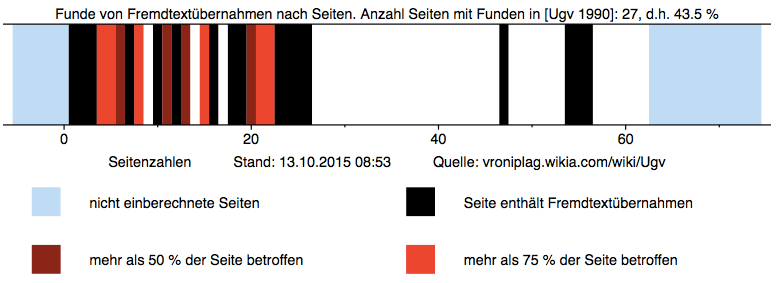
What is plagiarism?
Plagiarism means that one uses the work of somebody else without giving credit. Work can be broadly defined and includes written documents, but also, for example, video material. If you use others’ words, you must put them in quotation marks and cite your source, i.e., from where you obtained it. You must also give citations when using others’ ideas, even if you have described those ideas in your own words.
There are two main causes for plagiarism:
- Failure to cite correctly
- Misconduct: Intent to cheat
It is really essential to know the rules of the game to avoid conduct plagiarism.
Rules for plagiarism in Hohenheim?
Information on plagiarism are on this link: https://agrar.uni-hohenheim.de/plagiats.
Most importantly, the information sheet on how to avoid plagiarism can be found here: Link
For comparison, here are the guidelines of other universities:
At the University of Hohenheim with each work you are submitting you have to submit also a signed declaration that you can obtain here: https://www.uni-hohenheim.de/fileadmin/einrichtungen/agrar/Studium/Plagiate/Erklaerung_Arbeit_englisch.pdf
Submitted documents can be checked for plagiarism by the software Turnitin by the lecturers.
There are no university-wide rules regarding the format of citations at the University of Hohenheim: Discuss with your thesis advisor! However, there is an extensive document on the website of the University of Hohenheim that provides some information about scientific writing: https://agrar.uni-hohenheim.de/academic_writing_aid
Critical issue
What is the thin red line between plagiarism and correct scientific working?
The example in Figure 8 shows a term paper of a student in one of our classes, which contained multiple sentences that were verbatim copied from another source without references. These plagiated sentences were discovered with a plagiate detection software.

How does outlining help to avoid plagiarism?
A fairly simple approach to avoid plagiarism is outlining, which involves the following steps:
- Summarize/paraphrase the ideas/work/thoughts of others
- Write down the outlines of each concept of ideas
- Rewrite with your own words.
Summary
- Structuring and summarizing scientific information is essential for understanding complex texts, organizing ideas, and avoiding plagiarism.
- There are various text-based and visual tools and techniques to assist with this process.
- Text-based approaches include outlines and digital notes created with word processing programs, text editors and reference management programs as well es specialized programs for management of notes.
- Visual approaches include mind maps, concept maps, diagrams, infographics, and timelines.
- Plagiarism is the incorrect use of other’s text, images, etc.
- Outlining is a useful approach for active learning and avoiding plagiarism
Key concepts
- Outlining
- Tools for outlining
- Tools for knowledge management
- Plagiarism
Further reading
- There are no university-wide rules regarding the format of citations at the University of Hohenheim: Discuss with your thesis advisor! However, there is an extensive document on the website of the University of Hohenheim that provides some information about scientific writing: https://agrar.uni-hohenheim.de/academic_writing_aid
- “How to stop plagiarism” (2012) - Tips by ten experts on how to avoid plagiarism
- pautasso_ten_2013 - Some simple rules on working with literature when writing a literature review. Applies also to the introduction section of a Master’s thesis, for example.
Study questions
- How is plagiarism defined? What different types of plagiarism exist?
- Which techniques do scientists have available to avoid plagiarism?
- What are key advantages of outlining?
In-class activities
Plagiarism exercise
The following quiz was taken from the "Avoiding Plagiarism"sheet, UC Davis (https://ossja.ucdavis.edu/avoiding-plagiarism-mastering-art-scholarshipagiarism.pdf)
The original quote:
[A totalitarian] society … can never permit either the truthful recording of facts, or the emotional sincerity, that literary creation demands. … Totalitarianism demands … the continuous alteration of the past, and in the long run … a disbelief in the very existence of objective truth.'
Find out, which ones can be considered to be plagiates, and why?
Version A:
A totalitarian society can never permit the truthful recording of facts; it demands the continuous alteration of the past, and a disbelief in the very existence of objective truth.
Version B:
Orwell believed that totalitarian societies must suppress literature and free expression because they cannot survive the truth, and thus they claim it does not exist. (Bowker) pp. 336-337
Version C:
A totalitarian society can't be open-minded or allow the truthful recording of facts, but instead demands the constant changing of the past and a distrust of the very existence of objective truth. (Orwell)
Version D:
In his biography of George Orwell, Gordon Bowker discusses the themes of 1984, quoting a 1946 essay by Orwell: "'Totalitarianism demands … the continuous alteration of the past, and in the long run … a disbelief in the very existence of objective truth."' (Bowker p. 337, quoting Orwell, 1946)
Outlining of the opinion paper by Stam and McDonald
Background
The goal of the exercise is to:
- Jointly extract the main message(s) of a long text
- Try out different methods for outlining to understand the content of the paper
- Compare the different approaches to the outlining of the paper
Since the paper is entitled as ‘opinion’ paper, the goal is find out what actually their opinion is.
Approach
Each group will be assigned 1-2 paragraphs through which they read carefully.
Then, you will try to summarize the paragraphs using the following approaches:
- Identify the jargon terms or concepts you do not understand.
- Take the first sentence of a paragraph and write it down.
- Identify the most important sentence in the paragraph and write it down.
- Summarize the paragraph in a single sentence.
- Draw a simple cartoon (concept map, mind map or sketch) that summarizes the content or logic of the paragraph(s)
We will them assemble the paragraphs into different concepts and try to understand the message of the publication.
